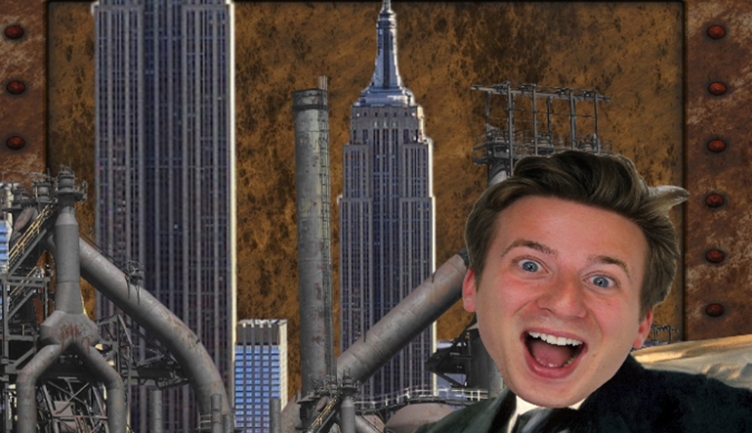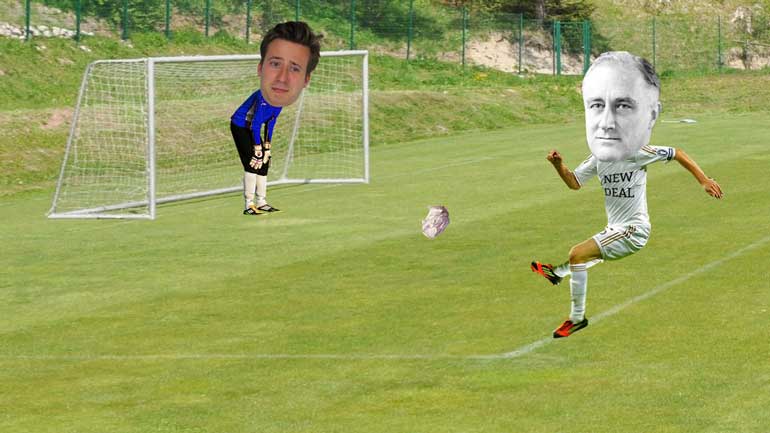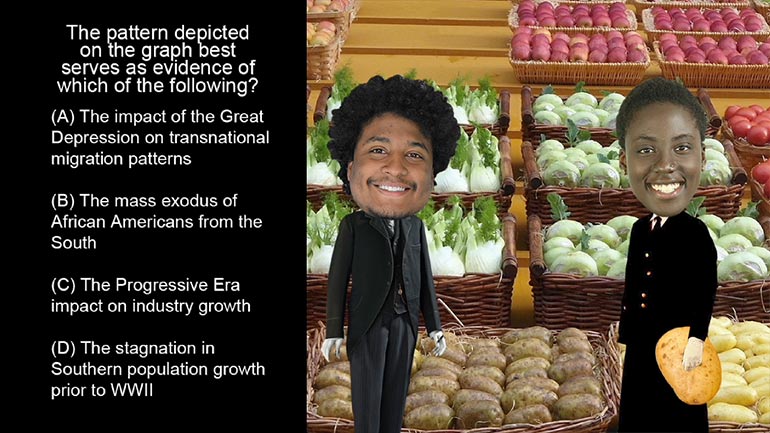ShmoopTube
Where Monty Python meets your 10th grade teacher.
Search Thousands of Shmoop Videos
Period 7: 1890–1945 Videos 19 videos
AP U.S. History 1.1 Period 7: 1890–1945. The Clayton Antitrust Act marked a new period in American labor relations because it...what?
AP U.S. History 1.2 Period 7: 1890-1945. Antitrust laws like the Clayton Act were a direct response to what development in the United States economy?
AP U.S. History 1.3 Period 7: 1890-1945. How did the rise of the corporations affect the social order of the time?
AP U.S. History 3.1 Period 7: 1890–1945 9 Views
Share It!
Description:
AP U.S. History 3.1 Period 7: 1890–1945. The pattern depicted on the graph best serves as evidence of which of the following?
Transcript
- 00:00
Thank you We sneak and here's your shmoop du jour
- 00:05
brought to you by stagnation the country run by dear
- 00:09
it's kind of a mess Turns out dear really aren't
- 00:11
great leaders stag dish you say's question the pattern depicted
- 00:16
on the graph best serves as evidence of which of
Full Transcript
- 00:18
the following and hear your potential answers All right right
- 00:21
here Depression and accidents progressive thinking Well believe it or
- 00:26
not where people live can say a lot about what's
- 00:28
going on in a country Well in the first half
- 00:30
of the twentieth century people were moving around a lot
- 00:33
right without even uber in particular african americans were hopping
- 00:37
around different regions like some kind of geographic hot potato
- 00:40
But what is their pattern of movement servas evidence of
- 00:44
could it be a the impact of the great depression
- 00:47
on transnational migration patterns Well the great depression was nearly
- 00:52
a decade of economic crisis People lost their jobs their
- 00:55
homes their minds are people went wherever they thought they
- 01:00
could find jobs and homes So transnational migration was definitely
- 01:05
a big thing during the great depression But if you
- 01:07
look at our graph the pattern we're seeing predates the
- 01:10
great depression and a graph is talking about the african
- 01:12
american population but everyone was affected by the great depression
- 01:16
Seriously even the pets were blue so we can say
- 01:19
goodbye to a could the graph service evidence of see
- 01:21
the progressive era impact on industry growth Well the progressive
- 01:26
era was a time when everybody ate a lot of
- 01:29
suits but the progressive era was a period where a
- 01:32
lot of people worked hard to get rid of corruption
- 01:35
in government and monopolies in the market It was time
- 01:38
of both social and political reform beginning around the eighteen
- 01:41
nineties and wrapping up in the nineteen twenties again these
- 01:44
days just don't sit well with our graph While social
- 01:47
and political reform might have positively impacted industry growth it
- 01:51
doesn't have much to do with the where african americans
- 01:53
were living at the times that eliminates see does the
- 01:56
graph indicate d the stagnation in southern population growth prior
- 02:01
to world war two Well the great depression which lingered
- 02:04
until world war two was probably a pretty good reason
- 02:07
not to start a family Poverty doesn't exactly put people
- 02:10
in a baby making mood but choice d specifies stagnation
- 02:14
In southern population growth and our graph isn't telling us
- 02:18
about southern population growth as a whole it focuses on
- 02:22
just a snippet of that population meaning we can cross
- 02:25
off d well that means that the pattern depicted on
- 02:27
the graph best serves as evidence of beef the mass
- 02:30
exodus of african americans from the south It seems little
- 02:34
topsy turvy but in the early nineteen hundreds the south
- 02:36
was heading north parts of it Any way you can
- 02:39
see it right on the graph The percentages of african
- 02:42
americans in the south decreased While there is growth across
- 02:45
the board in the other regions things in the south
- 02:47
warrant exactly peachy in the early twentieth century As you
- 02:50
can imagine the economy wasn't doing so hot segregation was
- 02:54
in full messed up swing and wages were just not
- 02:57
as high as they were elsewhere Getting out of there
- 02:59
was probably worth the hassle of packing So be is
- 03:03
the right answer now about the progresso era Anybody up 00:03:06.418 --> [endTime] for chicken noodle Uh
Related Videos
Ever heard of a "living document"? They eat and breathe just like the rest of us! They even walk around on their own two legs. Okay, fine—maybe t...
If the Puritans had gotten their way, religion would play a much larger role in lawmaking these days. Want to know more? Watch the video for all th...
What happened between the creation of the Articles of Confederation and the ratification of the current U.S. Constitution? This video analyzes the...
The Modernists thought the world had a lot of problems, and they were intent on fixing them—or at least talking about fixing them. Unfortunately,...
This video explains Federalism and the quest for a fair balance between state and national power. It covers the progression and compromises of Fede...























